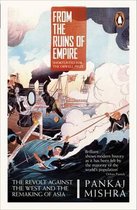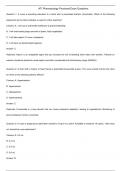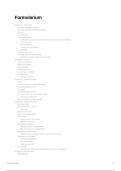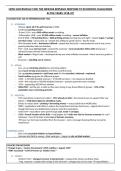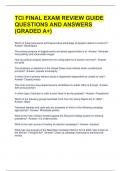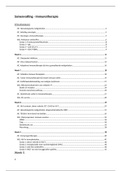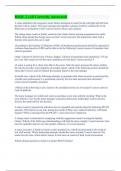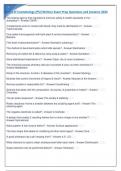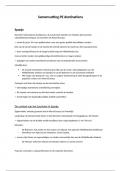Introducton to Internatonal Studies
Introducton to Internatonal Studies – Lecture 8
Che Guevara, Imperialism Speech
Imperialism turning men into wild, bloodthirsty animals
Similarity between Che Guevara and pan-Islamist/Asianist ideas?
Whole world is divided into two sides; unusual in the 20 th century, a diferent way of thinking,
because the natonal steps into the background. Guevara is using examples from diferent
countries, but the actual ideas he’s talking about is that there’s nothing inherent to natons to
being an imperialist in America or a Nazi in Germany.
So one way to read Mishra’s book: is that he’s talking about pan-Asianism and pan-Islamism, but
underlying all this is a kind of nostalgia for communism; and in this way, we can be critcal of
him; Mishra critcizes Orientalism while utlizing Orientalism
Last Lecture
Chapter 3 Liang Qichao’s China and the Fate of Asia (1st half)
Focus Points:
o Japan: Asian or not? (128)
o Western politcal order understood as Confucianism (144)
o Kang’s Confucian Reformaton (146-7)
Contrast Yan Fu quote on p. 146 with Kang’s ideas 146-7.
o Yan Fu and Liang on social darwinism (148, 151)
o Sun Yat-sen and Liang Qichao cooperaton and competton (157)
The Japanese now tried to bring Sun and Liang together… but… in late 1899
Liang was ordered by Kant to travel…
o Capitalism and Imperialism (159-160)
Chapter Overview
The Boxer Rising
Pan-Asianism: The Pleasures of Cosmopolitanism [most important sectonn
Liang and Democracy in America
o Key person who is central to Treaty of Versailles: Widrow Wilson
(The Temptatons of Autocracy and Revoluton)
Questons
Were missionaries fair game for atack in the Boxer Rebellion?
o Was it okay, morally or politcally, for this to happen? Was it okay to kill the
missionaries?
o Western imperialism against China might be bad, but these missionaries are just trying
to spread Christanity – so why hold them responsible for imperialism?
o Missionaries as representatves of Christanity linked to imperialism, demonstratve of
Western countries power; similarity between how missionaries spread Christanity and
spread of imperialism; the actual form of Christan mission used Western imperialist
ideology and vice versa
,Jana Ahmad
Introducton to Internatonal Studies
o Christanity as about individualist capitalist work through naton states
o Strongest argument for conversion; look how strong Western powers are! If you
convert, you can become powerful too
What was the link in China between Christan mission and capitalism?
Is the rise of militarist leaders in ant-imperialist (natonal liberaton) movements good?
o For most of Chinese imperial history, there were two types of gov. ofcials: civil ofcials
and military ofcials; military ofcials were always of much lower status than civil
ofcials
o This is stll the case in most Anglo-Saxon countries today
o Could be a good thing because they might win some batles, could be bad because it
could be damaging through war
o In Chinese history it’s quite tricky; but it’s actually asking: is the use of violence good?
Violence does get things done at tmes
What is the relatonship between democracy on the one hand, and racism and inequality on the
other?
Are liberalism and communism natural opponents or allies?
o Can be perceived as opponents
o Communism requires revoluton to achieve democracy and freedom, but liberalism
doesn’t usually have revoluton as an ideology – it has a reformist agenda
Maps
In 20th century, a new place comes into being: the region called, the Asia Pacifc
Asia Pacifc is an economic reality; all the countries on the rim of the Pacifc are very closely
economically interrelated with each other; can’t trade without each other; they’re not politcally
integrated, but they are very much economically integrated
Been an increasing reality since 1900
A lot of politcal events have happened in parallel though, in the countries on the rim of the Asia
Pacifc; partly because of the trade relatons.
Mentmeter questons:
the Boxer Rebellion and Indian Mutny shared the following similarites: disorganized and
spontaneous
Turn of the century Tokyo was NOT home to natonalist dissidents from which one of these
countries? Ethiopia (wasn’t colonized at that point)
Yuan Shikai was allowed to become President of the Republic of China because: he had beter
foreign relatons
The Monroe Doctrine gave the US the right to intervene in the afairs of any Latn American
country if: it helped American interests
The “Open Door” policy of the US called for equality: among foreign powers exploitng China.
How did it end? It ended with the 2 nd World War
The biggest infuence which turned Liang Qichao against democracy was: his observaton of the
USA
,Jana Ahmad
Introducton to Internatonal Studies
Woodrow Wilson (according to PBS)
Industrializaton transforming America in 20 th century
Woodrow Wilson, former politcal scientst, president of US, and progressive
Enacted multple laws, reduced tarifs
In WWI, said US has duty to make world into safer place created League of Natons, but US
couldn’t join League of Natons
Does Mishra agree with this portrayal of Woodrow Wilson as progressive? No
Events
Missionaries in China as symbol of West
Boxer Rebellion
Chinese Revoluton (1911)
Northern Expediton (1926-8)
o After the warlords take over northern China; slow march north to takeover coastal China
Monroe Doctrine (1830s – current)
o Last American statesperson to actually say, “Because of the monroe doctrine, i am
allowed to intervene in this country because it serves American interests”: Hilary Clinton
used it to say that US could possibly invade Uruguay (they didn’t do anything, but she
hinted at it)
Open Door Policy (1899 – 1949)
o Ended in 1949 as a policy, but ended in 1937 when Japanese invaded China too
Focus Points
The Boxers, the Indian Mutny, shamanism, missionaries, religion and colonialism 161
o Religious element of the Boxers
Militarism among Chinese leaders 164
Social Darwinism and Han natonalism 164-165
o Both this point and militarism are RELATED
o A lot of people who became elite leaders in China, when went back
o A new, professional elite of army men soon emerged, partcularly under Yuan Shikai
(1859– 1916), a general in the old Qing army. The military academy established by Yuan
south of Beijing initally trained, among others, the future Natonalist leader – and
Mao’s rival – Chiang Kai-shek (1888–1975). A glamorous militarist strain appeared in
Chinese urban life which had so far conferred prestge on silk-robed Confucian
gentlemen with a gift for poetry and calligraphy. Voluntary organizatons dedicated to
modernizing and strengthening China sprang up in both China and the Chinese diaspora
Links with insttutons to central government
Partcularly shocking in China because of history of having literary elite, also
because of intersecton with social Darwinist
o The reforms also had consequences not obvious to the Qing reformists. Students who
had become deeply politcized by their stay in Japan returned to form enduring ant-
Qing alliances with like-minded graduates of the new schools and military academies.
, Jana Ahmad
Introducton to Internatonal Studies
Many of these were radical natonalists in the European Social Darwinist style,
borrowing from the examples of Germany and Japan to posit a Han ‘natonal essence’
against alien Manchus.
Social Darwinist idea in Europe; linked to idea of natons, that idea had already
been there (that we’re all Germans, so we should have a German state and
speak German); but this was a new idea in China. I.e. in Germany, ideas of
German natonalism arose before social Darwinist ideas. In east China, and
specifcally China, natonalism came into being within intellectual world already
believing in social Darwinism, when believed that races were diferent
organisms, and natons related to this.
So race theory were there, which confronted these Chinese people with the
need for a race, which became basis for Han Ethnic natonalism, which thank
God has never really progressed too much
This is also linked to the military educaton these people have
Liang’s “New People” vs Kang’s “Great Community” 166
o Idea that the way to reform China is to create a new Chinese person
o To create a new people is to destroy the old Manchu regime and create a new kind of
Chinese natonalism
o In his famous series of essays, ‘Discourses on the New People’, Liang argued that
nothing less than a total destructon of the Manchu regime could save China. ‘I have
thought and thought again’, he wrote, ‘about the popularly accepted system in China
today; there is almost not a single aspect of it which ought not to be destroyed and
swept away, root and branch.’ Invoking Social Darwinism again, Liang warned, ‘when a
race cannot meet the exigencies of the tmes, it cannot endure’.59 Freedom was the
absolute necessity for China, he wrote, invoking Patrick Henry’s famous words, ‘Give me
Liberty or give me Death.’
o At same tme, Kang Youwei is more interested in Buddhism and ideas of Universalism,
imagining a universalist post-natonalist harmony. Originally Kang Youwei was Liang’s
teacher, but they diverge.
Mishra on universalism 170
o While Kang was in India, moving into the private dream world that would increasingly
make him politcally irrelevant, Liang travelled to Canada and the United States for a
fund-raising tour. This major trip outside Asia proved to be a turning point in his
intellectual career
Mishra here seems to be suggestng that universalist ideas are unrealistc
While Mishra critcizes militarist natonalism, he views the alternatve as a world
of dreamers
Wilson on capitalism and naton 171
o Secton preparing the ground for Pankaj Mishra’s very critcal approach to Woodrow
Wilson and US
o Which partcular element of American life is Pankaj Mishra trying to relate to the
American situaton? Inequality and Race
o Through Liang Qichao’s memories of living in America, Mishra tries to take us into daily
life of US and relate it to internatonal relatons policies US takes in 20 th century.

